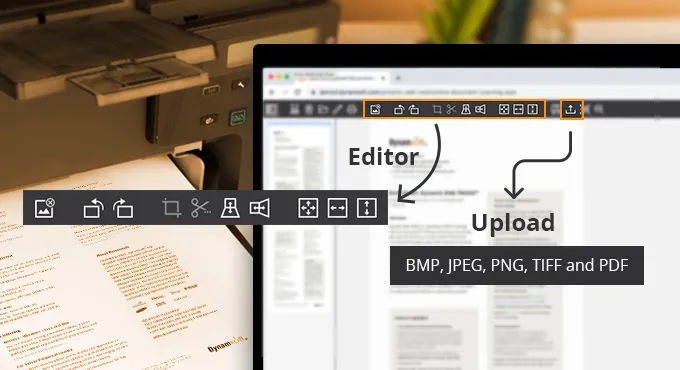مجموعة أدوات تطوير البرمجيات لمسح الوثائق لنشر تطبيقات الويب الخاصة بك بسرعة
مجموعة أدوات تطوير البرمجيات لمسح الوثائق لنشر تطبيقات الويب الخاصة بك بسرعة
موثوق بها من قبل أكثر من 5300 شركة لقوتها وأمانها
Dynamic Web TWAIN هي مجموعة أدوات تطوير البرمجيات لمسح الوثائق على المتصفح مصممة للسرعة، الدقة والقدرة على التوسع. ببضعة أسطر من JavaScript، يمكنك تطوير تطبيقات قوية لمسح الوثائق في جميع المتصفحات الشائعة.
- دعم شامل لبرامج تشغيل الماسح الضوئي بما في ذلك TWAIN، WIA، ICA، SANE و eSCL.
- دعم عبر المتصفح على Windows، macOS، Linux والجوال.
جرب العرض التوضيحي عبر الإنترنت
تحميل النسخة التجريبية لمدة 30 يومًا
الميزات
1. مسح الوثائق على مستوى المؤسسات
مسح عشرات الآلاف من الصفحات
- التخزين المؤقت على القرص المملوك لمسح الوثائق غير المحدود في الجلسة
- خدمة 64 بت متاحة للتعامل مع البيانات الكبيرة
مسح الوثائق بسرعة لا مثيل لها
- يمكن استدعاء واجهات البرمجة التطبيقية المستهلكة للوقت بشكل غير متزامن
- الأحداث المدفوعة بالمشغل لتبسيط سير العمل التجاري
2. تحرير الصور الجاهزة للاستخدام
العارض والتحرير المضمن
- عارض الصور القابل للتخصيص
- واجهة المستخدم المضمنة للتعليقات النصية، التكبير والتشويه

تصدير ورفع
- العديد من خوارزميات الضغط لتقليل حجم الملف، بما في ذلك ترميز JPG لـ TIF
- حفظ إلى PDF، BMP، TIF، JPG أو PNG على محركات الأقراص المحلية أو الشبكة
- تحميل مقسم أو متعدد الخيوط للتعامل مع البيانات الكبيرة
3. ضمان أمان بياناتك
تبقى بياناتك آمنة وتبقى داخل شبكتك
- الدعم المضمن لـ HTTPS مع شهادة SSL قابلة للتكوين
- التوقيع الرقمي
- تشفير البيانات أثناء النقل وفي الراحة
- يلزم الإذن للوصول إلى الملفات المحلية
- يتم حذف البيانات المؤقتة عند إغلاقات SDK غير المتوقعة
4. قم ببناء دليل على المفهوم في ساعة
أكثر من 60 مشروع عينة لمساعدتك على إنشاء POC مخصص بسرعة.
التكامل السهل
- العميل: JavaScript، VBScript، HTML5، HTML. يدعم أطر العمل JavaScript (AngularJS، ReactJS، Vue.js)
- الخادم: Nginx، IIS، Tomcat، Apache، ASP.NET (C#/VB.NET)، PHP، jQuery، Node.js، JSP، ASP، والمزيد

التوزيع السريع
- التثبيت X-Copy — لا يلزم تثبيت على الخادم
- المثبت MSI — قم بالتثبيتات الدفعية لشبكة كاملة
لماذا Dynamic Web TWAIN
- الأداء اللا مثيل له للتطبيقات التجارية الأكثر تطلبًا.
- منظمة حاصلة على شهادة ISO 27001 التي تتبع أفضل الممارسات في مجال الأمن المعلوماتي.
- خدمة العملاء الحائزة على جوائز: لا يوجد التزام دعم قبل البيع لمساعدتك في تحديد القدرة على التنفيذ لسيناريو عملك.
الشهادات
فوجي فيلم
ساعدت مجموعة أدوات تطوير البرمجيات في تسريع وقت التطوير وتمكين قدرات التقاط الصور وإدارة الوثائق الإضافية. يضمن استخدام الأمان Sandbox أن تطبيقات مسح الصور على المتصفح مفصولة بأمان عن أجهزة التصوير والاتصال بدون متاعب مع الأجهزة المتوافقة مع TWAIN. تساعد Dynamic Web TWAIN SDK أكبر منشآت ومقدمي الرعاية الصحية في الدولة على تشغيل أو تبسيط عمليات سير العمل للمرضى.
فوجي فيلم
فريق IBM Datacap
نتيجة للعمل مع Dynamsoft، يمكن للعملاء IBM حول العالم الآن استخدام قدرات المسح الضوئي الجديدة على كلا من Windows و Mac® OS X. بمجرد مسح الوثائق، يمكنهم استخراج المعلومات من الوثائق لتبسيط العمليات التجارية والحصول على رؤى الأعمال باستخدام التحليلات.
فريق IBM Datacap
Lockheed Martin
بعد بحث شامل، كنا سعداء جدا للعثور على أداة مسح ضوئي قابلة لتلبية احتياجاتنا.
ديفيد هارينج، Lockheed Martin
American HealthTech
وجدنا أن Dynamic Web TWAIN SDK من Dynamsoft عمليا حلا جاهزا لتنفيذ مكون المسح والتقاط لحل EHR الذي يستخدم على نطاق واسع. بالإضافة إلى ذلك، كان فريق Dynamsoft مستجيبًا جدًا لاحتياجات الدعم الخاصة بنا.
جوزيف سميث، مدير المنتج، لـ American HealthTech
جاهز للخطوة التالية؟
تحميل النسخة التجريبية المجانية
أو



 Blog
Blog